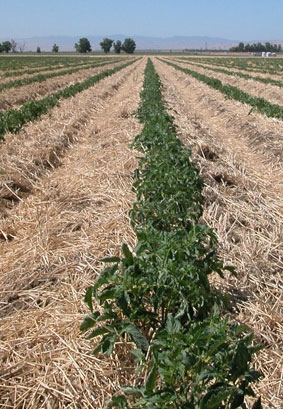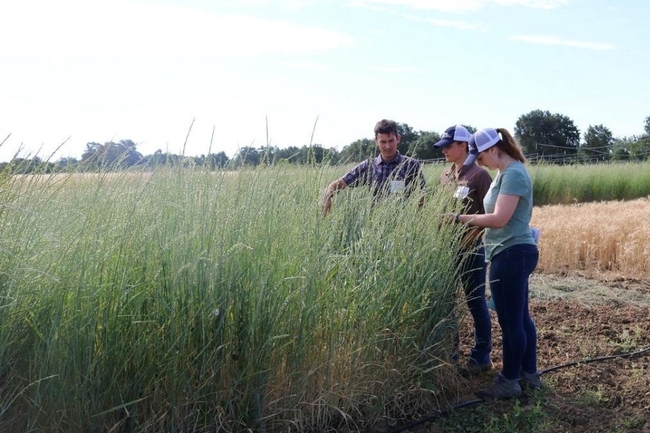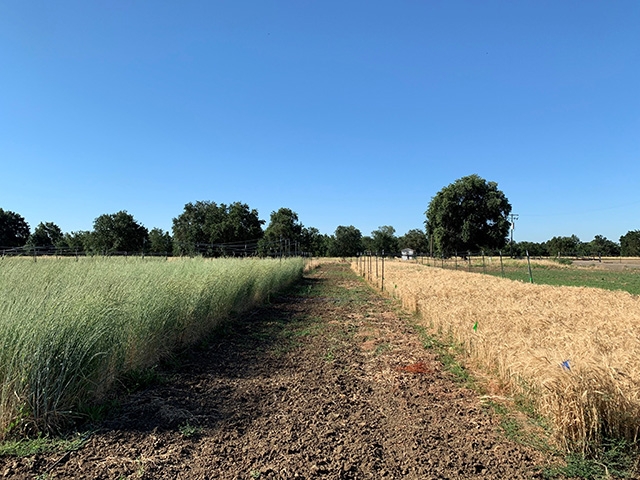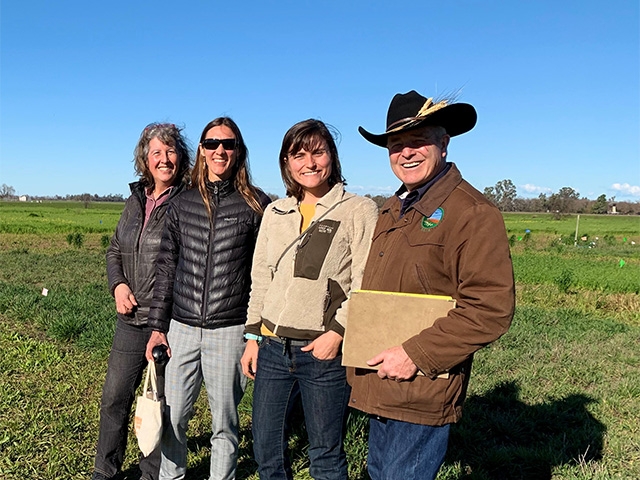
Posts Tagged: no-till
No-till annual wheat better for soil health in California’s climate
One more reason to adopt sustainable cultivation
California wheat farmers could both maintain their yields and improve soil health by growing annual wheat without tilling the soil year after year.
This could be one more encouragement to farmers to adopt a sustainable practice commonly called conservation tillage, no-till or minimum-till cultivation, impacting how we grow a grain that supplies about 20 percent of the calories and protein for people around the world.
A new study, by a team led by Mark Lundy, University of California Cooperative Extension specialist in UC Davis' Department of Plant Sciences, offers new insight for decades-long discussions around soil conservation, sustainable agriculture and climate-warming emissions related to growing our food. The study has been published in the journal Soil and Tillage Research. For the first time, researchers have shown that annual wheat that is not tilled each year is better for stashing carbon in the soil than perennial wheatgrass, while still yielding more crop in Central California.
Previous studies have looked at annual wheat that is tilled each year, annual wheat that is not tilled, and a cousin species, perennial intermediate wheatgrass (trademarked Kernza), which also is not tilled. But until now, no one has looked at all of the benefits and trade-offs together. Most importantly, “no one has ever controlled for tillage,” Lundy said. “And, no one has compared annual wheat to perennial intermediate wheatgrass over multiple years in a Mediterranean climate, which is what we have in California.”
This study also is unique because it delves into the deeper question of what is going on in the soil that drives the different results for carbon there. Soil carbon reflects various processes linked to plant activity and soil health. Measuring the different forms of soil carbon may also signal whether a farming system is accumulating carbon in the soil over time – a plus for reducing climate-warming gases in the atmosphere.
“Measuring soil carbon is complex and nuanced,” said Kalyn Taylor, the lead author on the paper. “We started this experiment because we wanted to know whether and how plant activity and tilling or not tilling would affect the carbon story belowground in California's climate.”
“When we started this study, we thought the crop being perennial or annual would drive the differences in carbon storage in the soil,” Lundy added. Specifically, they had expected perennial wheatgrass would lead to more carbon in the soil because of its deeper, better-established root system. “But that's not what we found,” he went on. “What we found was, it was the lack of tillage, plus the level of productivity of common annual wheat, that made the difference in soil carbon here in California.”
Soil carbon in annual vs. perennial grain
In 2017, Lundy, then-graduate-student Taylor, UC Davis Professor Emeritus Kate Scow and others on the team started measuring different forms of soil carbon in test plots at Russell Ranch, west of campus. Plots were planted with annual wheat that was tilled each spring, annual wheat that was not tilled and perennial intermediate wheatgrass (Kernza) that also was not tilled.
Each year, the researchers measured the carbon present in the soil, the amount of soil organisms (which have carbon in their bodies) and the amount of material the plants created.
At the end of three growing seasons, they found that land planted with no-till, common, annual wheat had the highest amount of soil organisms, measured as biomass, of the three treatments.
The researchers also found soil carbon is more likely to remain stable in the no-till, annual plots, compared to both tilled wheat and wheatgrass.
In addition, the no-till, annual wheat produced plant material more consistently than the perennial wheatgrass across the three years, which saw variation in rainfall.
“Overall, annual wheat grown without soil disturbance or tillage had both higher productivity and higher potential for storing carbon in the topsoil than perennial wheatgrass in our Mediterranean climate,” Lundy said.
Related research
“No-till annual wheat increases plant productivity, soil microbial biomass, and soil carbon stabilization relative to intermediate wheatgrass in a Mediterranean climate,” is online now and will be published in the January 2024 edition of Soil and Tillage Research.
The team also found that tilled annual wheat vs. Kernza stores total carbon at different depths in the soil profile and hosts distinct soil fungal communities, primarily in the root zone and topsoil: Taylor, K., Samaddar, S., Schmidt, R., Lundy, M. and Scow, K., 2023. Soil carbon storage and compositional responses of soil microbial communities under perennial grain IWG vs. annual wheat. Soil Biology and Biochemistry, p.109111.
Previous work comparing the perennial grain known as intermediate wheatgrass (trademarked Kernza) to annual wheat had not distinguished the extent to which soil health benefits are a function of the perennial nature of the crop. Read the story here.
This story was originally published on the UC Davis News site.
No-till agriculture has substantial benefits for Central Valley residents

The article featured a number of California farmers who sang the praises of the no-till farming method.
- "We definitely save money through higher production, less water usage and lowered equipment and fuel costs," said Modesto farmer Jesse Sanchez
- "We started in 1985 using the no-till method, and since then we've doubled our yield potential," said Fritz Durst, a Yolo County farmer
- "I not only get great production, I save a great deal by not buying expensive tilling equipment, and I look to double my production in times of little rainfall because no-till increases the water-storing capacity of the soil," said Michael Crowley, a Turlock farmer
UC Agriculture and Natural Resources (UC ANR) conservation agriculture expert Jeff Mitchell said the slow implementation of no-till in California is "largely a matter of our farmers not being familiar with no-till practices."
Tillage became popular in California in the 1930s. The agricultural systems developed in the state were wildly successful.
"Because they worked so well, and were so profitable, nobody has felt they should make a change," said Mitchell, who is a UC ANR Cooperative Extension specialist based at the UC Kearney Agricultural Research and Extension Center.
Mitchell is chair of the Conservation Agriculture Systems Innovation Center, a group of farmers, researchers, USDA scientists and ag industry professionals who are working together to spread the word about and encourage adoption of no-till production. Key CASI messages were shared in the Comstock article.
“Since water does not evaporate as quickly in no-till fields, savings in water cost are easy to determine,” Mitchell said. “In addition, fewer pesticides are often needed and farmers also save money by the diminished need to buy the expensive tilling equipment and to pay people to run them.” He adds that soil in the fields, no longer exposed by the tilling, remains richer in its biodiversity and can sustain higher yields. Compaction of the soils, caused by the heavy tilling equipment, is reduced.
Conservation ag may allow farmers to be part of carbon ‘cap and trade’

Published research results provide evidence that farmers will need to get credit for sequestering carbon if such an opportunity arises in the future. In addition, the conservation practices have been shown to offer other environmental benefits – such as reducing dust emissions and cutting water use – while increasing yield and profit.
Initiated in 1999 at the UC West Side Research and Extension Center, the study is a tomato-cotton rotation grown in four treatments: 1) standard tillage, 2) standard tillage and a winter cover crop, 3) no till and no cover crops, 4) no till and a winter cover crop.
“It took about eight years until we saw an increase in carbon in the top foot of soil,” said the lead author Jeff Mitchell, a UC ANR Cooperative Extension specialist. Mitchell is working with UC Davis soil scientists Randy Southard, Will Horwath and Kate Scow, UC ANR Cooperative Extension advisors in Fresno County Dan Munk, Kurt Hembree and Tom Turini, and USDA Natural Resources Conservation Service partners Dennis Chessman and Rob Roy.
Standard tillage is the way most annual crops are managed in the San Joaquin Valley today. The soil is tilled to break up organic matter and reshape beds each year after the crop is harvested. Under no-till management, the plants are left after harvest and the new crop is planted amidst the untouched dead plant residue.

The hike in soil carbon was found in plots where cover crops were planted in the winter and the soil was not tilled. Carbon in the soil rose from the standard baseline levels for this region in California, about 8.8 tons per acre, to 12.9 tons per acre, an increase of about 4.2 tons.
“That is a significant increase in carbon,” Mitchell said.
Carbon sequestration is part of the process of carbon cycling around the earth. Atmospheric carbon – carbon dioxide – is taken up by plants in the process of photosynthesis. The plant respires some of the carbon; the rest is converted into sugars and makes up the structure of the plants' stems, leaves and fruit.
In time, the plant dies, decomposes and the carbon that was part of the body of the plant remains in the soil. Micro-organisms convert the carbon into more stable forms of carbon, like humus.
“This more stable form of carbon in the soil is what contributes to soil organic matter and carbon sequestration in the soil,” Mitchell said. “The soil becomes a carbon sink.”
A benefit of storing carbon in the soil is reducing the amount of carbon in the atmosphere.
“We're reducing the atmospheric load of carbon dioxide, a greenhouse gas that plays an important role in global warming,” Mitchell said. “Proving a stable storage location for carbon could allow agriculture to be part of future cap and trade programs.”
An initiative to maintain and enhance sustainable natural ecosystems is part of UC Agriculture and Natural Resources Strategic Vision 2025.



